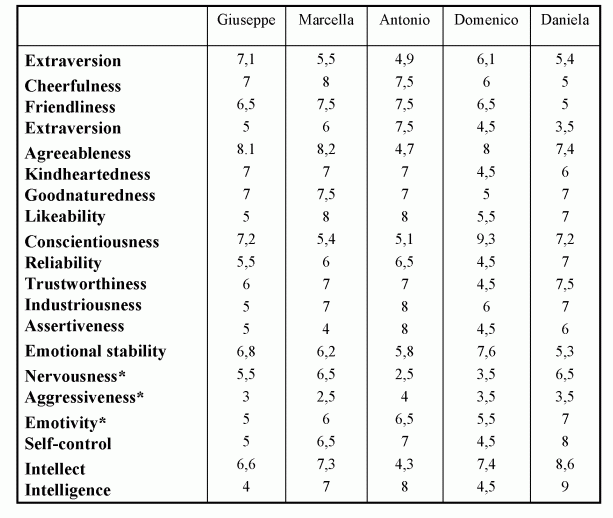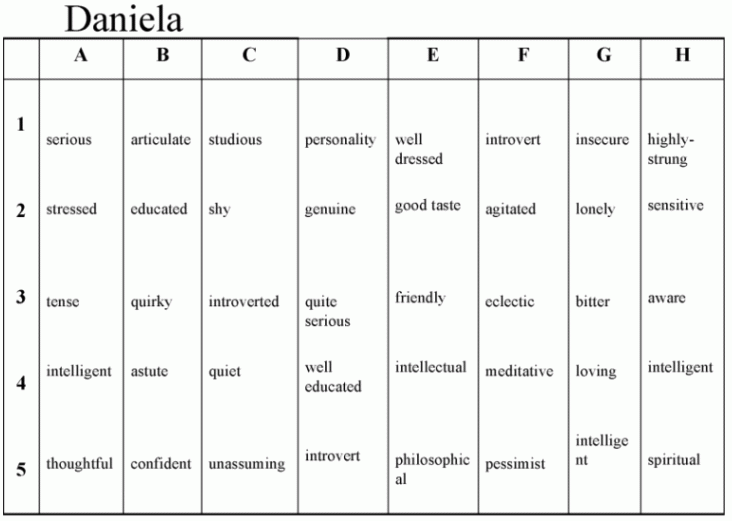University of Rome III
e-mail:
web: www.boylan.it
Why adapting to your negotiating partner's
language is all to your advantage:
empirical evidence
supporting intercultural accommodation theory.
Patrick Boylan
University of Rome
III
e-mail:
![]()
web: www.boylan.it
|
ABSTRACT Accommodation theory (Giles & Smith 1979) has claimed that adapting to the language and culture of a negotiation partner will enable one to communicate most effectively. Little empirical evidence has ever been given for such a claim, however. The present paper offers some experimental data to
If this small scale experiment were to be tested on a
---- Giles H. & Smith P. (1979). "Accommodation
Theory: |
1. Postulates

Therefore:

For a full explanation of the concepts in the above two slides, see:
P. Boylan, "Language as Representation, as Agency, as Being" In: M. Parry et al. (eds.), Revolutions in consciousness: local identities, global concerns in languages and intercultural communication. Glasgow: University of Glasgow Publications, 2002. Also available on the Internet: click here -›...
2. Definition

For a full explanation of what the concept expressed in this slide means, see: Coupland N. & Giles H. (1988). "Introduction: The communicative Contexts of Accommodation." Language and Communication, 8: 175-82.
3. Theorem derived from the above postulates and definition
Greater accommodation-è-Greater receptivity
Giles et al. (1977) have offered empirical evidence corroborating the above theorem.
Background: Canadians from the English-speaking provinces, in communicating in French with French Canadians, accommodate their language to different degrees. Many adopt a French Canadian accent, a few adopt a Parisian French accent, most simply speak scholastic French with a strong English accent.
Giles' experiment dealt with the French Canadians' reactions to two speakers from "British Canada": one whose accent tended towards the "outgroup" (French Canadian) standard and one whose accent was decidedly "ingroup" (English). The reactions were classified as positive or negative.

4. Objections and counter-objections
The findings offered by Giles et al. may be criticized since:
a) the impact speakers make in interacting in a foreign language is not limited to their pronunciation and prosody;
b) what counts is the interplay between the communicative situation, the referential content expressed and the overall mode of expression (non-standard pronunciation can very often be offset by, for example, appropriate non-verbal expressiveness). What counts is the total effect.
This interplay can produce cases which apparently invalidate the theorem. For example:
cases in which an outgroup or "foreign" accent seems to augment receptivity:
cases in which the foreign speaker's overly idiomatic pronunciation and language contradict expectations and thus lower receptivity.
Nonetheless:
a.) the findings suggested by Giles et al. match with everyday observation. People do attune to their interlocutor's speech to make what they say more understandable and acceptable: parents switching to "baby talk" to coax their children; job applicants second guessing not only what a prospective employer wants to hear but how s/he wants to hear it; advertisers adopting a target population's expressive style (localized versions of a Levis ads use the "incorrect" language popular among youths in each country), etc.;
b.) cases of successful communication in spite of an apparent lack of accommodation do not disprove the theorem when speakers use their foreign ways to correspond to hearer expectations: a French singer accentuating her/his accent in English or German to convey even more charme; Lee jeans ads using English even in countries where knowledge of English is not widespread to suggest they are "(more) genuinely American", etc. Indeed, such communicative activity seems to be perfectly "attuned";
c.) nonetheless, overgeneralization remains a risk
and therefore empirical verification of overall accommodation
in a wide range of situations is necessary. Until such
verification is done, however, the data furnished by Giles et al.
(and other similar studies) can be taken as evidence warranting the
use of the theorem as a working hypothesis.
5. Additional theorem derived
from what has preceded:
cultural accommodation subsumes all other kinds
(the more a speaker internalizes the hearer's value
system and expresses a common "being" through language and
other behaviour, the more receptive the hearer will be -- even if the
speaker has not mastered the pragmatic usages and the linguistic
rules of the hearer's language).
Corollary 1: Degrees of accommodation can be defined on the basis of how much speakers have internalized their interlocutors' language as a mode of being.
This corollary is important because it affirms that one can internalize an interlocutor's "mode of being" without necessarily having mastered her/his language, i.e. without having made any linguistic accommodation. In other words, this corollary takes accommodation theory out of the narrow domain of linguistics and places it in the wider perspective of communication theory.
Moreover, this corollary lays the basis for teaching Intercultural Communication as a discipline distinct from instruction in the target culture's language. For example, a German negotiator can learn to show she is perfectly attuned to her Iranian interlocutor by her use of forms of address and metaphors, by her use of certain verb tenses more than others, by her choice of subjects and line of reasoning, by her prosody and use of silence, by her non-verbal behaviour, etc. -- all this whether the negotiation takes place in German, in Persian or in English.
Thus, it has been possible to establish a hierarchy of degrees of accommodation using, as the principal criterion, the answer to the question: "How much has the speaker (have the speakers) made a move toward or into the other party's world?"
For a full explanation of these concepts, see: P. Boylan, "Accommodation through a Transformation of Consciousness" In: Koch K. & Muggin T., Globalisation, foreign languages and intercultural learning", London: South Bank University Press (forthcoming). Now available on the Internet: click here -›...
Corollary 2: the inverse will also hold:
linguistic/pragmatic accommodation will not subsume cultural accommodation
(This means that using the hearer's language and pragmatic usages perfectly does not necessarily augment the hearer's receptivity if "modes of being" continue to be divergent, i.e. if the speaker has not internalized the value system of the hearer's culture).
In testing this inverse formulation, it must be kept
in mind that a person perceived as a "foreigner" or member
of an outgroup (somatic traits + clothing, for example) is generally
seen as having accommodated culturally if s/he follows the
hearer's linguistic rules and pragmatic usages perfectly. Tests
must therefore create situations in which the situation/content make
it clear that speaker and hearer do not have a common "mode of
being".)
6. Empirical verification of the additional theorem
For a full explanation of the concepts in the following slides, see: Bianconi L. "Culture and Identity: Issues of Authenticity in Another Value System". Paper presented at the 12th Sietar Europa Congress (Vienna, April 10-13, 2002). Available on the Internet at: http://sietarcongress.wu-wien.ac.at/
What effect do Italian speakers of English create on the average British listener, just from their way of speaking?
Does the grammatical quality of the Italians' English influence judgments? Or is some other factor more important, for example their "way of being"? If so, how to measure such an elusive variable?
These were the research questions Bianconi raised and then attempted to answer with the project described in the paper indicated above.
First, Bianconi rated the personality of speakers (Italians living in London who have accommodated to the local language, usages and culture to varying degrees) using the following test (essentially a psychological test with cultural implications, since no empirically-verified cultural-values test was found). Although the test was printed in English, the researcher allowed for a reacculturation period with the speakers (she offered them Italian food, drink, and conversation) to ensure, insofar as possible, that the answers to the test would reflect their "native" selves.


Some time later, Bianconi made videos of the Italian subjects presenting themselves using the English language. This time, the subjects were put through a reverse acculturation period to ensure they were behaving as they do normally with English people.
The researcher, helped with British friends, performed a subjective evaluation of each Italian speaker's degree of linguistic, pragmatic and cultural authenticity as a speaker of English. (No empirically-verified rating scheme was known to exist for the cultural aspects.)
English judges were then shown the video recordings and asked to rate the speakers by writing their general impressions and then by choosing from among a series of adjectives (correlated to the IPIP-NEO Personality Inventory categories).
Profiles were made of the judges' inventory of each subject's personality. A sample profile follows. It is of "Daniela", a young Italian woman who, when using English, manifested a high degree of acculturation (Daniela seemed to switch value codes together with linguistic codes: she reasoned and acted differently when using either Italian or English.) Daniela had a less than native degree of linguistic/pragmatic competence, however.

It was hypothesied that if both the test findings and the judges' ratings corresponded, the speaker could be said to have conveyed her/his native (Italian) personality perfectly well through the appropriate use of English. If ratings diverged from findings, the difference could be attributed to "noise" in the speaker's manner of communicating.
The high rate of correlation among the various data showed that Daniela managed to convey her "true" self by not being herself (as she is in Italy) but rather by being the "translation" of that self into the British sociocultural context.
(Good "communicative" translators do precisely that: they allow themselves to change the words and even concepts expressed in the original in order to convey as faithfully as possible what the original conveys to people who know the language.)
And in fact, other Italian speakers, who accommodated less than Daniela from a cultural standpoint, failed to convey themselves and, indeed, evoked negative stereotypes of Italians. This was true whether their linguistic/pragmatic competence was above or below that of Daniela's.
Thus Daniela's accommodation at the level of
"language as being" would seem to be the key factor in
enabling her to make herself understood.
7. Objections and counter-objections
a.) too many dependent variables: the test does not permit correlations;
b.) testing scheme inappropriate, rating scheme unreliable;
Nonetheless,
a.) as a pilot project the experiment points the way to further research;
b.) Bianconi's attempt at quantitative research
required her to better define what is involved in successful
intercultural communication; this in turn enabled her to put into
clearer focus her own successes and failures in intercultural
communication. Thus, while Bianconi's conclusions do not have
the (relative) validity of a controlled laboratory experiment, they
do have the (relative) validity of clinical observation made by an
experienced clinician.
8. Future developments
The "soft" (social) sciences are still
seeking a research model appropriate to the highly subjective domains
they deal with. The last comment in part 7 points the way
toward the use of a hybrid quantitative/qualitative inquiry where the
quantitative research serves to heighten the subjective
evaluations. This is the model followed by clinicians in
medical wards. Further research should therefore not only
answer the objections raised in point 7 but also investigate the
usefulness of such a research paradigm.